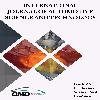Determination of Optimum Operating Conditions of Different Types of Intercooler Designs in Supercharged Engines
In the rapidly developing automotive technology, the efforts to achieve high performance with less fuel consumption is one of the most important issues today. The purpose of the supercharged systems developed for this reason is to send more air into the cylinder. For high engine performance and low exhaust emission values, the intake air temperature, which is heated in the turbo-compressor and has the oxygen concentration (the amount of oxygen in the unit air) decreased, must be kept at certain levels. Therefore, the heated air between the compressor outlet and the cylinder inlet must be cooled. In this study, different types of intercoolers were designed and analyzed with the help of ANSYS Fluent (CFD) program, and optimum conditions were tried to be obtained by comparing them with each other.
Keywords:
intercooler, turbocharger CFD analysis, optimization,
___
- [1] Öz A. Investigation of the effect of L5Cu compound in diesel fuel on in-cylinder pressure, engine performance and exhaust emissions. International Journal of Oil, Gas and Coal Technology. 2021:28(1):101-114.
- [2] Öz A. Experimental evaluation of L5Ni addition to diesel fuel in a turbo diesel engine. Indian Journal Chemical Technology. 2019: 26;158-163.
- [3] Güney B, Öz A. Microstructure and chemical analysis of NOx and particle emissions of diesel engines. International Journal of Automotive Engineering and Technologies. 2020;9(2): 105-112.
- [4] Güney B, Öz A. Microstructure and chemical analysis of vehicle brake wear particle emissions. Avrupa Bilim ve Teknoloji Dergisi. 2020:19;633-642.
- [5] Mazman M. Gizli Isı Depolaması ve Uygulamaları. Doktora Tezi, Çukuroava Üniversitesi, Fen Bil. Ens., Adana, 2006.
- [6] Çengel Y, Boles M. Mühendislik Yaklaşımıyla Termodinamik. Güven Bilimsel Kitabevi, 2008, İzmir.
- [7] Öztürk H. Isı Depolama Tekniği. Teknik Yayınevi, 2008, Ankara.
- [8] Öztürk HH. Güneş Enerjisinin Gizli Isı Tekniği ile Depolanması. Tesisat Mühendisliği Dergisi. 2005: 100; 16-31.
- [9] http://biyokure.org/isi-degistirici-cesitleri/7009/ 26.08.2016.
- [10] http://www.emo.org.tr/ekler/fe77ac7060e716f_ek.pdf?dergi=298/17.09.2016.
- [11] http://otomobilteknoloji.blogspot.com.tr/2016/06/turbo-nedir-turbo-sarj-sistemi-calisma-prensibi.html/10.09.2016.
- [12] http://www.motorsanas.com/tr/turbosarjnedir.html/11.09.2016.
- [13] Canlı E. İçten Yanmalı Motorlarda Aşırı Doldurma ve Ara Soğutma Sistemleri ,Yüksek Lisans Tezi, Fen Bilimleri Enstitüsü, Selçuk Üniversitesi, 2010.
- [14] Muqeem M. Turbocharging With Air Conditioner Assisted Intercooler. IOSR Journal of Mechanical and Civil Engineering. 2012:2(3);38-44.
- [15] Dağlar S. Ağır Vasıta Araç Motorları için Tek Kademeli Değişken Geometrili ve Çift Kademeli Turboşarj Karşılaştırması ve Seçimi. Yüksek Lisans Tezi. İstanbul Teknik Üniversitesi, Fen Bilimleri Enstitüsü, 2012.
- [16] Özülkü M. Aşırı Doldurmalı Dizel Bir Motorda Ara Soğutmanın (Aftercoolıng) Motor Performansı Ve Egzoz Emisyonlarına Etkisinin Deneysel Analizi. Yüksek Lisans Tezi İstanbul Teknik Üniversitesi, Fen Bilimleri Enstitüsü, 2002.
- [17] Zhang Q, Qin S, Ma R. Simulation and experimental investigation of the wavy fin-and-tube intercooler, Case Studies in Thermal Engineering. 2016;8:32-40.
- [18] Dwivedi VD, Rai R. Modeling and Fluid Flow Analysis of Wavy Fin Based Automotive Radiator. Int. Journal of Engineering Research and Applications. 2015;5(1):17-26.
- [19] Wais P. Influence of Fin Thickness and Winglet Orientation on Mass and Thermal Efficiency of Cross-Flow Heat Exchanger. Applied Thermal Engineering. 2016;102:184-195.
- [20] Mifdal MYA, Nuraida MH, Norzalina O, Shamil AH. Turbo Intercooler Cooling System. International Journal of Engineering Science Invention. 2015:2319 – 6726.
- [21] Lajqi NB, Baxhaku BI, Lajqi SB. Effect of Intercooler on Turbocharged Diesel Engine Performance. 13th International Research/Expert Conference, Hammamet, October 2009, Tunisia.
- Yayın Aralığı: Yılda 4 Sayı
- Başlangıç: 2016
- Yayıncı: Otomotiv Mühendisleri Derneği
